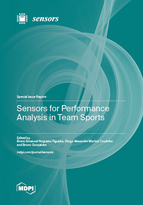Sensors for Performance Analysis in Team Sports
A special issue of Sensors (ISSN 1424-8220). This special issue belongs to the section "Physical Sensors".
Deadline for manuscript submissions: closed (31 December 2024) | Viewed by 44735
Special Issue Editors
Interests: entropy; kinematics; training; sport biomechanics; sports science; exercise physiology; exercise performance
Special Issues, Collections and Topics in MDPI journals
Interests: sports science; medicine and rehabilitation
Special Issues, Collections and Topics in MDPI journals
Interests: sports science; sport performance; sport training; elite sport; physical education; complex system; collective behaviour
Special Issues, Collections and Topics in MDPI journals
Special Issue Information
Dear Colleagues,
In recent years, performance analysis in team sports has focused on a quest for reliable information that will help to optimise the training process and ultimately the competitive outcome. With this in mind, technology has been used to monitor and control the physical and physiological demands of players in both training and competition. Similarly, players’ technical actions and movement patterns have been analysed to provide a holistic perspective of performance. However, technological development is an ongoing and systematic process that produces new sensors almost daily to collect data, advanced metrics to analyse the information, and powerful visualisation techniques to display the information. This results in a huge untapped potential for improving sports performance. This Special Issue will offer a review of the existing literature, focusing on studies that address the use of sensors to measure team sport performance and the influence of lifestyle habits on player performance.
All types of studies will be considered, including original research, systematic reviews, meta-analyses, validation studies, and conceptual articles.
Potential topics to be covered include:
- Tracking of player movement patterns (e.g., sensors that track player position in both training and competition);
- Analysis of technical and tactical behaviour in team sports using sensors (e.g., approaches for tracking and interpreting player performance);
- Sensors that enable tracking of physical and physiological performance in team sports (e.g., systems that track players’ external and internal load);
- Wearable sensors that capture health-related variables (e.g., heart rate, blood, sweat, and interstitial fluid);
- Biomechanical sensors that analyse movement in team sports (e.g., motion analysis);
- Original studies using sensors to compare player behaviour in team sports (e.g., use of sensors to compare player performance under different conditions during training or competition);
- Validation studies investigating new sensors for performance analysis (e.g., validation of systems for recording player behaviour);
- Statements and reviews synthesising expert knowledge (e.g., conceptual papers, systematic reviews).
Dr. Bruno Emanuel Nogueira Figueira
Dr. Diogo Alexandre Martins Coutinho
Dr. Bruno Gonçalves
Guest Editors
Manuscript Submission Information
Manuscripts should be submitted online at www.mdpi.com by registering and logging in to this website. Once you are registered, click here to go to the submission form. Manuscripts can be submitted until the deadline. All submissions that pass pre-check are peer-reviewed. Accepted papers will be published continuously in the journal (as soon as accepted) and will be listed together on the special issue website. Research articles, review articles as well as short communications are invited. For planned papers, a title and short abstract (about 100 words) can be sent to the Editorial Office for announcement on this website.
Submitted manuscripts should not have been published previously, nor be under consideration for publication elsewhere (except conference proceedings papers). All manuscripts are thoroughly refereed through a single-blind peer-review process. A guide for authors and other relevant information for submission of manuscripts is available on the Instructions for Authors page. Sensors is an international peer-reviewed open access semimonthly journal published by MDPI.
Please visit the Instructions for Authors page before submitting a manuscript. The Article Processing Charge (APC) for publication in this open access journal is 2600 CHF (Swiss Francs). Submitted papers should be well formatted and use good English. Authors may use MDPI's English editing service prior to publication or during author revisions.
Keywords
- technical and tactical behaviour
- physical and physiological analysis
- movement patterns
- talent identification technology
- training and game monitoring
- wearable sensors
- motion analysis
- motion tracking
- sensor validation
Benefits of Publishing in a Special Issue
- Ease of navigation: Grouping papers by topic helps scholars navigate broad scope journals more efficiently.
- Greater discoverability: Special Issues support the reach and impact of scientific research. Articles in Special Issues are more discoverable and cited more frequently.
- Expansion of research network: Special Issues facilitate connections among authors, fostering scientific collaborations.
- External promotion: Articles in Special Issues are often promoted through the journal's social media, increasing their visibility.
- Reprint: MDPI Books provides the opportunity to republish successful Special Issues in book format, both online and in print.
Further information on MDPI's Special Issue policies can be found here.









